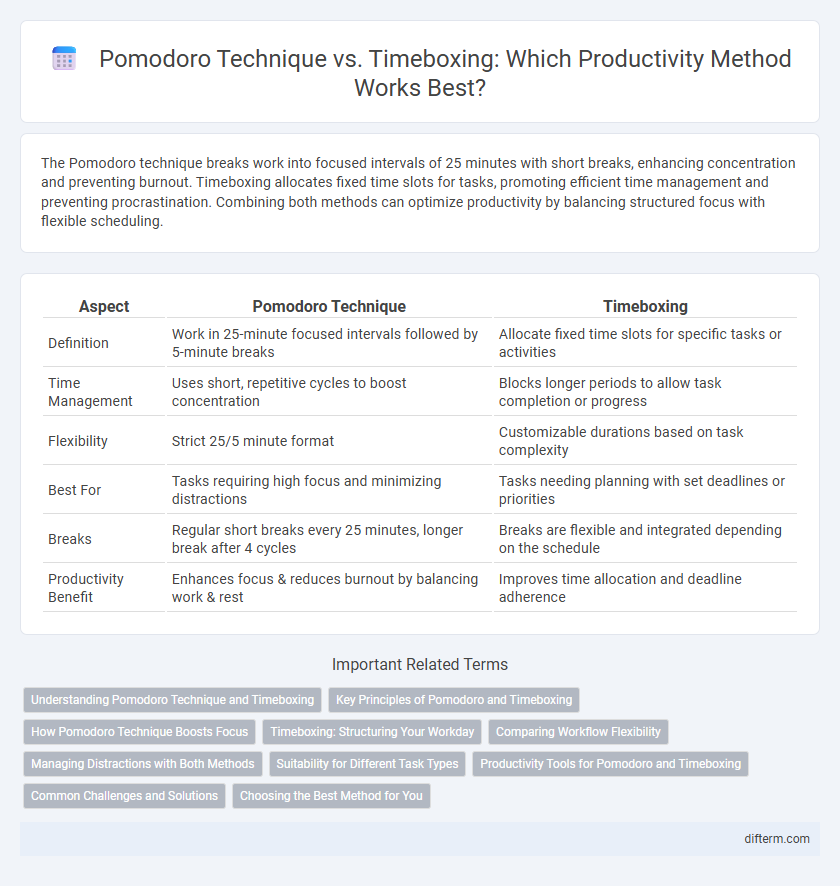The Pomodoro technique breaks work into focused intervals of 25 minutes with short breaks, enhancing concentration and preventing burnout. Timeboxing allocates fixed time slots for tasks, promoting efficient time management and preventing procrastination. Combining both methods can optimize productivity by balancing structured focus with flexible scheduling.
Table of Comparison
| Aspect | Pomodoro Technique | Timeboxing |
|---|---|---|
| Definition | Work in 25-minute focused intervals followed by 5-minute breaks | Allocate fixed time slots for specific tasks or activities |
| Time Management | Uses short, repetitive cycles to boost concentration | Blocks longer periods to allow task completion or progress |
| Flexibility | Strict 25/5 minute format | Customizable durations based on task complexity |
| Best For | Tasks requiring high focus and minimizing distractions | Tasks needing planning with set deadlines or priorities |
| Breaks | Regular short breaks every 25 minutes, longer break after 4 cycles | Breaks are flexible and integrated depending on the schedule |
| Productivity Benefit | Enhances focus & reduces burnout by balancing work & rest | Improves time allocation and deadline adherence |
Understanding Pomodoro Technique and Timeboxing
The Pomodoro Technique enhances productivity by dividing work into focused 25-minute intervals called "pomodoros," separated by short breaks to sustain mental agility. Timeboxing involves assigning fixed time periods to specific tasks or activities, promoting disciplined scheduling and preventing overextended work sessions. Both methods optimize time management by structuring work into manageable segments that increase focus and efficiency.
Key Principles of Pomodoro and Timeboxing
The Pomodoro technique hinges on dividing work into 25-minute focused intervals called Pomodoros, separated by short breaks to enhance concentration and prevent burnout. Timeboxing allocates fixed time periods for specific tasks, emphasizing strict boundaries to improve time management and task prioritization. Both methods prioritize structured time allocation but differ in duration control and flexibility, making them effective for boosting productivity through disciplined focus and task segmentation.
How Pomodoro Technique Boosts Focus
Pomodoro Technique boosts focus by breaking work into 25-minute intervals, minimizing distractions and maintaining mental clarity. This method leverages short, consistent timed sessions to enhance concentration and reduce burnout, unlike timeboxing which allocates broader time segments for varied tasks. Studies show Pomodoro users experience increased task engagement and improved memory retention during work periods.
Timeboxing: Structuring Your Workday
Timeboxing enhances productivity by allocating fixed time periods to specific tasks, preventing procrastination and encouraging focused work within defined limits. This method promotes efficient task management by integrating breaks and work intervals directly into your schedule, fostering consistent energy levels and reducing decision fatigue. Structuring your workday through timeboxing aligns priorities with realistic deadlines, resulting in higher output quality and better time awareness.
Comparing Workflow Flexibility
Pomodoro technique structures work into fixed 25-minute intervals with short breaks, promoting consistent focus but limiting flexibility for varying task lengths. Timeboxing allocates set time blocks tailored to specific tasks, allowing greater adaptability in workflow management and task prioritization. Using timeboxing can better accommodate complex projects requiring varied focus durations, while Pomodoro suits routine tasks benefiting from strict periodic breaks.
Managing Distractions with Both Methods
The Pomodoro technique manages distractions by segmenting work into 25-minute intervals followed by short breaks, promoting sustained focus and reducing the urge to multitask. Timeboxing allocates fixed time slots to tasks, creating clear boundaries that help minimize interruptions and keep attention aligned with priorities. Both methods enhance productivity by structuring work periods to mitigate distractions and improve concentration.
Suitability for Different Task Types
The Pomodoro technique excels in managing repetitive or short-duration tasks by breaking work into 25-minute intervals, enhancing focus and reducing mental fatigue. Timeboxing offers more flexibility, allowing allocation of specific time blocks tailored for complex or varied projects, which benefits tasks requiring deep work and strategic planning. Selecting the appropriate method depends on task complexity, duration, and the need for structured breaks versus extended concentration periods.
Productivity Tools for Pomodoro and Timeboxing
Productivity tools for the Pomodoro technique, such as Focus Booster and TomatoTimer, specialize in breaking work into 25-minute intervals to enhance concentration and manage breaks effectively. Timeboxing tools like Toggl Plan and Clockify enable users to allocate fixed time slots to specific tasks, fostering better time management and task prioritization. Integrating these tools can optimize workflow efficiency by combining structured focus periods with flexible schedule allocation.
Common Challenges and Solutions
The Pomodoro technique and Timeboxing both face challenges like interruptions and maintaining strict adherence to time limits, often causing productivity lapses. Solutions involve setting clear boundaries to minimize distractions and using flexible buffers within timeboxes or Pomodoros to accommodate unexpected tasks. Employing tools such as task management apps and setting realistic goals enhances focus and helps overcome common pitfalls associated with both methods.
Choosing the Best Method for You
Selecting the best productivity method depends on personal work habits and task types, with the Pomodoro technique offering focused intervals ideal for interruptible tasks and timeboxing providing structured blocks suited for larger projects. Understanding individual attention span and deadline flexibility helps determine whether 25-minute sprints or predefined time allocations maximize efficiency. Experimenting with both methods allows for customization that aligns with specific productivity goals and workflow preferences.
Pomodoro technique vs Timeboxing Infographic

 difterm.com
difterm.com